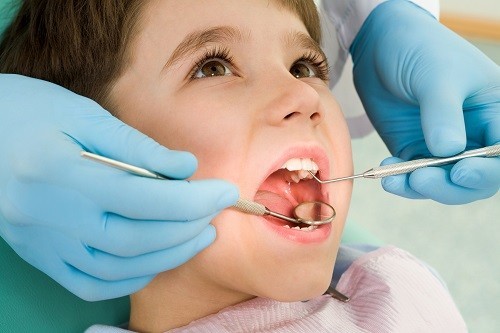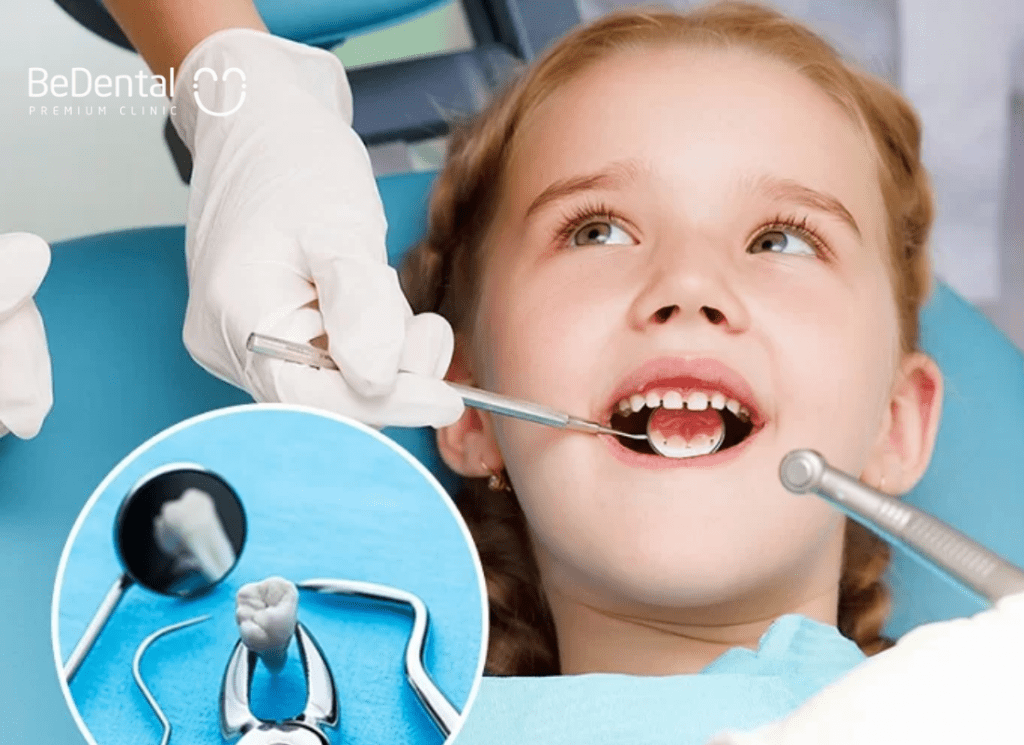How to treat a 5 year old with a cavity in their upper jaw ? – How to treat a 5-year-old with a cavity in their upper jaw effectively ?
Cavity is a common problem in children, especially at the age of 5. In fact, dental issues can occur at any age, both in adults and children. While cavities are not a serious condition, they should be treated promptly and effectively to avoid potential consequences and oral health risks in the future. So, what are the signs that a child has a cavity at the age of 5? What to do when a 5-year-old has a cavity in their upper jaw? Let’s find out in this article for effective and timely treatment for your child!
Signs of a cavity in a 5-year-old’s upper jaw
Children are most susceptible to dental cavities. This is because their awareness of oral hygiene and care is not yet well-developed compared to adults. This can be the main reason why children are prone to this condition.
In the case of cavities in children, it can be understood that when teeth are not properly cleaned, bacteria can easily reside in the oral cavity. These bacteria then produce acids that attack the tooth enamel of the child. As a result, the tooth surfaces attacked by acid gradually lose their protective enamel layer, leading to the appearance of brown and black spots. Over time, these spots develop into cavities in the teeth.

A 5-year-old with a cavity in their upper jaw will have the following signs on their teeth:
- Cavities typically cause gradual erosion and formation of holes in the teeth. This can result in pain and discomfort. Therefore, the initial manifestations of a cavity problem in a child are the occurrence of pain and discomfort when biting or chewing food.
- When a child has a cavity, their teeth become very sensitive. Therefore, children often experience tooth sensitivity and discomfort when exposed to or eating hot or cold foods.
- The condition of cavities will progressively worsen, leading to increasing levels of pain and more frequent episodes of tooth sensitivity without any reason.
- In addition, a 5-year-old with a cavity in their upper jaw may also have bad breath.
- Cavities also significantly affect a child’s ability to chew. Furthermore, it can lead to weakening of the child’s overall health.
Causes of cavities in 5-year-old children
Cavities are not uncommon, especially in young children. It is not only due to their lack of oral hygiene awareness compared to adults but also related to their health and dietary habits. To know effective treatment methods for children, it is important to understand the root causes of cavities in children. Here are the most common causes of cavities in 5-year-old children.

Poor oral hygiene care
A 5-year-old with cavities in their upper jaw may be due to poor oral hygiene care.
As mentioned earlier, young children lack awareness of oral hygiene to keep their teeth strong and healthy because they are too young to pay attention to these issues. However, parents also have a casual attitude and pay less attention to oral care for their children. This can explain why cavities occur in many children, especially in 5-year-olds. Inadequate oral hygiene care may include the following:
Inadequate and insufficient brushing, not following the recommended number of times per day. In a day, children may have 3 or more meals, but limited oral hygiene care can lead to food residues remaining on the teeth without being thoroughly removed.
Improper brushing techniques also result in the failure to thoroughly remove food plaque, allowing them to survive in the oral environment and making the teeth more susceptible to cavities.
The bacteria that accumulate in food plaque are one of the main causes of cavities. These bacteria reside and create conditions for acid production, which attacks the tooth enamel of young children, causing gradual enamel loss and the appearance of cavities.
Unhealthy eating habits
Another major factor that makes a child’s teeth more susceptible to cavities is their unhealthy eating habits. Because young children are in the stage of exploration and like to try different types of food they see. The types of food that children often eat are also one of the factors that harm their oral health.

Especially foods with high sugar content such as candies, soft drinks, chocolates, etc. These are the types of food that young children really enjoy eating. However, these are the types of food that can easily cause cavities in children. When consuming these foods, they tend to stick to the teeth and if not promptly removed through oral hygiene, they create conditions for bacteria to reside and ferment carbohydrates, producing acid that attacks the tooth enamel and makes the teeth susceptible to infection.
Therefore, parents should be mindful of limiting and controlling the types of food their children eat. Especially foods with high sugar content and increasing the intake of green vegetables.
Due to the child’s health condition
Sometimes cavities in children can also be caused by their health condition. Some common causes of cavities related to the child’s health include:
Children with chronic allergies are often prone to cavities in their teeth.
Children who have a habit of breathing through their mouth often experience dry mouth, which increases the risk of cavities.
Furthermore, some children may have weak immune systems, lack essential minerals like calcium and iron, which affects the health of their teeth and makes them more susceptible to bacterial attacks in the oral cavity, causing their teeth to weaken over time.
Lack of Fluoride
Another factor that can lead to cavities in children is a lack of Fluoride. This is also a common issue in children at this age. Fluoride is an important component that helps protect teeth, which is why toothpaste and mouthwash often contain Fluoride. In addition to its protective properties, Fluoride also helps restore early-stage tooth damage, allowing the teeth to recover quickly. Therefore, children who lack Fluoride are at a higher risk of cavities.

How to treat a 5 year old with a cavity in their upper jaw effectively
Typically, the treatment for cavities will depend on the severity of the decay. In some cases, it may not be necessary to extract the tooth and alternative treatments can be considered. So, what can we do to effectively address the issue of cavities in the upper jaw of a 5-year-old child? Below, BeDental will provide you with some solutions for effective at-home oral care and cavity treatment for a 5-year-old:
Some effective home remedies for cavities in the upper jaw
When it comes to treating cavities in young children, especially in the early stages, parents should prioritize choosing safe and gentle methods to apply to the child. Some natural remedies for cavity treatment with simple ingredients that can be applied at home are:
Green tea leaves
Green tea is one of the effective methods for addressing and treating cavities. This ingredient has antibacterial and anti-inflammatory properties, and it is highly effective in cleaning the teeth. That’s why green tea is commonly found in toothpaste or mouthwash products.
How to do it:
Take 2-3 clean green tea leaves, crush them, and have the child chew on them (specifically targeting the area with cavities). Let the child keep them in their mouth for about 3-5 minutes to allow the tea to take effect. Afterwards, have the child rinse their mouth with clean water. It is recommended to do this 2-3 times a day to reduce any pain or discomfort caused by the cavities, as well as to promote good antibacterial action and improve the condition of the cavities.

Honey
In addition to green tea, honey is also one of the beneficial ingredients for oral health in young children. Honey contains a high amount of minerals that can help effectively reduce cavities. Additionally, the sweet taste of honey makes it more pleasant for children to use.
How to do it:
Use about a spoonful of honey and have the child hold it in their mouth. Guide the child to push the honey towards the area with cavities so that the ingredient can come into contact with the surface of the teeth and maximize its effectiveness. Repeat this process twice a day consistently to achieve the most effective results and gradually eliminate cavities.
Saltwater
Saltwater is an easy-to-make ingredient that can be prepared at home. Similar to the above ingredients, saltwater has strong antibacterial properties and is very effective in cleaning the oral cavity, making it suitable for treating dental diseases, including cavities.
How to do it:
Simply dissolve a few grains of sea salt in warm water to create a diluted salt solution, or you can buy saline solution from pharmacies. Have the child hold the saltwater solution in their mouth for about 1 minute, then rinse their mouth with clean water. Be consistent and perform this routine 2-3 times a day for optimal results.
Treating cavities at the dentist
If the cavities worsen or you are unsure about treating the child at home and want to address the cavities as soon as possible, you can take the child to the dentist for examination and advice on the best treatment. In a dental clinic, cavities are typically treated using one of the following two methods:

Tooth filling
This is a method of treating cavities in a 5-year-old child at a mild level of tooth decay that is not too severe. In this case, if the cavities in the 5-year-old child are small and have not significantly affected the structure of the tooth, the dentist will recommend filling the cavities.
The tooth filling process is simple and ensures the safety of the child. First, the dentist will clean the child’s mouth and remove any diseased tooth tissues and infected bacteria. Then, the dentist will proceed to clean the cavities thoroughly. Next, the dentist will use materials to fill and seal the cavities, protecting the tooth from harmful factors.
Afterward, the filling will be hardened using a specialized curing light, completing the tooth filling process. This ensures that the cavities are treated without causing pain or discomfort to the child. The dentists will also provide instructions to parents on how to take care of the child’s oral health after the tooth filling.
Tooth extraction
Tooth extraction is a method that is recommended when no other suitable options are available. This method is applied when a 5-year-old child has severe cavities with large cavities that are close to losing the tooth. The tooth extraction process for a child is performed under sterile conditions to ensure absolute safety. The dentists will use methods to minimize pain and discomfort for the child. After the tooth is extracted, it is possible to remove any inflammation in the oral cavity and prevent the spread of cavities.

Cavities in the teeth of a 5-year-old child are not uncommon. However, parents should also take note and treat them early to ensure the oral health of their child and prevent unfortunate consequences in the future.
Tư vấn chuyên môn bài viết:
BÁC SĨ DƯƠNG THỊ THÙY NGA
BEDENTAL - TOP STANDARD DENTISTRY SYSTEM
In HANOI
Address 1: 7B Thi Sach St, Ngo Thi Nham, Hai Ba Trung Dist, Ha Noi. - 0934.61.9090
Address 2: No 129 Hoang Ngan, Yen Hoa, Cau Giay Dist, Ha Noi. - 0934.61.9090
In HO CHI MINH
Address 1: 53 -55 -57 Pho Duc Chinh St, Nguyen Thai Binh, Dist. 1, Ho Chi Minh. - 0766.00.8080
Working: 9am - 8pm everyday
Website: https://bedental.vn/en/






Pingback: Loose, gaps, receding, and black borders on dentures – Some causes and remedies – Be Dental